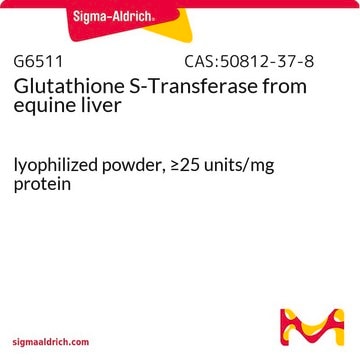GS66
GST M2-2, Recombinant Human
Synonym(s):
GST4, GSTM, GTHMUS, glutathione S-transferase mu 2
Sign Into View Organizational & Contract Pricing
All Photos(1)
About This Item
UNSPSC Code:
12352200
NACRES:
NA.26
Recommended Products
biological source
human
Quality Level
recombinant
expressed in E. coli
Assay
>95% (SDS-PAGE)
form
frozen liquid
specific activity
93.3 units/mg protein
mol wt
26 kDa
concentration
2.55 mg/mL
storage temp.
−70°C
Gene Information
human ... GSTM2(2946)
General description
using spectrophotometric determination of 1-chloro-2,4-dinitrobenzene (CDNB) conjugation with reduced glutathione (1 mM) in 100 mM NaPO4 (pH 6.5) at room temperature.
Biochem/physiol Actions
Glutathione S-transferase mu 2 (GSTM2) is an enzyme that in humans is encoded by the GSTM2 gene. Glutathione S-transferases (GSTs) are a family of enzymes that play an important role in detoxification by catalyzing the conjugation of many hydrophobic and electrophilic compounds with reduced glutathione. Based on their biochemical, immunologic, and structural properties, cytosolic and membrane-bound forms of glutathione S-transferase are encoded by two distinct supergene families. At present, eight distinct classes of the soluble cytoplasmic mammalian glutathione S-transferases have been identified: alpha, kappa, mu, omega, pi, sigma, theta and zeta. The GSTs are thought to function in xenobiotic metabolism and play a role in susceptibility to cancer, and other diseases.
This gene encodes a glutathione S-transferase that belongs to the mu class. The mu class of enzymes functions in the detoxification of electrophilic compounds, including carcinogens, therapeutic drugs, environmental toxins and products of oxidative stress, by conjugation with glutathione. The genes encoding the mu class of enzymes are organized in a gene cluster on chromosome 1p13.3 and are known to be highly polymorphic. These genetic variations can change an individual′s susceptibility to carcinogens and toxins as well as affect the toxicity and efficacy of certain drugs.
Storage and Stability
The enzyme should be used by the end-user customer within 1 year of receipt.
Storage Class Code
10 - Combustible liquids
WGK
WGK 1
Flash Point(F)
Not applicable
Flash Point(C)
Not applicable
Certificates of Analysis (COA)
Search for Certificates of Analysis (COA) by entering the products Lot/Batch Number. Lot and Batch Numbers can be found on a product’s label following the words ‘Lot’ or ‘Batch’.
Already Own This Product?
Find documentation for the products that you have recently purchased in the Document Library.
Ruwani Hewawasam et al.
Biochemical pharmacology, 80(3), 381-388 (2010-04-27)
Ca(2+) release from the sarcoplasmic reticulum through cardiac ryanodine receptors (RyR2) is essential for heart function and is inhibited by the carboxy terminal domain of glutathione transferase M2-2 (GSTM2-C) and derivative fragments containing helix 6. Since a peptide encoding helix
Mao-Wen Weng et al.
DNA repair, 4(4), 493-502 (2005-02-24)
Cellular detoxification is important for the routine removal of environmental and dietary carcinogens. Glutathione S-transferases (GST) are major cellular phase II detoxification enzymes. MRC-5 cells have been found to exhibit significantly higher GST activity than human H1355 cells. This study
Lan Wei et al.
The international journal of biochemistry & cell biology, 40(8), 1616-1628 (2008-03-01)
We show that a glutathione transferase (GST) protein, which is recognised by an antibody against the muscle-specific human GSTM2-2 (hGSTM2-2), is associated with the lumen of the sarcoplasmic reticulum (SR) of cardiac muscle, but not skeletal muscle. We further show
Ihn Han et al.
Proteomics, 11(3), 352-360 (2011-01-27)
Ovarian teratoma is a dermoid cyst in the ovary that contains mature tissues such as hair, teeth, bone, thyroid, etc. To understand the molecular mechanisms of ovarian teratoma growth, a comparative proteomic analysis was undertaken using mesenchymal stem cell-like cells
Ying-Hao Shen et al.
Tumour biology : the journal of the International Society for Oncodevelopmental Biology and Medicine, 35(5), 4007-4015 (2014-01-09)
Hepatocellular carcinoma (HCC) is one of the most serious health problems worldwide. As in many other diseases, environment and genetic factors are believed to be involved in the pathogenesis of HCC. Numerous epidemiologic investigations including case-control and cohort studies have
Our team of scientists has experience in all areas of research including Life Science, Material Science, Chemical Synthesis, Chromatography, Analytical and many others.
Contact Technical Service






